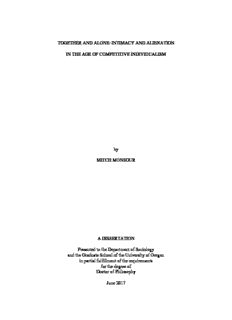
INTIMACY AND ALIENATION IN THE AGE OF COMPETITIVE INDIVIDUALISM by MITCH ... PDF
Preview INTIMACY AND ALIENATION IN THE AGE OF COMPETITIVE INDIVIDUALISM by MITCH ...
TOGETHER AND ALONE: INTIMACY AND ALIENATION IN THE AGE OF COMPETITIVE INDIVIDUALISM by MITCH MONSOUR A DISSERTATION Presented to the Department of Sociology and the Graduate School of the University of Oregon in partial fulfillment of the requirements for the degree of Doctor of Philosophy June 2017 DISSERTATION APPROVAL PAGE Student: Mitch Monsour Title: Together and Alone: Intimacy and Alienation in the Age of Competitive Individualism This dissertation has been accepted and approved in partial fulfillment of the requirements for the Doctor of Philosophy degree in the Department of Sociology by: Gregory McLauchlan Chairperson Richard York Core Member Jill Harrison Core Member Patricia Curtin Institutional Representative and Scott L. Pratt Dean of the Graduate School Original approval signatures are on file with the University of Oregon Graduate School. Degree awarded June 2017 ii © 2017 Mitch Monsour iii DISSERTATION ABSTRACT Mitch Monsour Doctor of Philosophy Department of Sociology June 2017 Title: Together and Alone: Intimacy and Alienation in the Age of Competitive Individualism I begin by discussing structural alienation in the United States and its relationship to the pursuit of romantic love. I argue that romantic love is idealized due the lack of community inherent in a competitive, individualistic society; the romantic partner becomes a replacement for the community individuals once relied on for material and psychological needs. Despite the allure of romantic love, the norms and values associated with it often undermine the development of intimacy, as does the larger society in which the relationship is situated. I refer to this phenomenon as the romantic contradiction. I then discuss some of the factors that contribute to the romantic contradiction, such as the commodification of relationships in a market-based economy, impression management in dating, and the role of gender in heterosexual relationships. Central to this dissertation, I investigate the dominant ideology of romantic love by conducting a textual analysis of the ten most popular romantic comedies and self-help books on romantic relationships from 2006-2010. My findings suggest the dominant ideology of romantic love promotes long-term, monogamous relationships as the primary way to meet a person’s psychological and physical needs. Furthermore, the ideal relationship is based on gendered needs and responsibilities: men are expected to provide iv material and physical protection, while women are expected to provide emotional support and sexual intimacy. The ideology encourages a dependency between women and men and various forms of inequality. It also reinforces individualism in relationships by placing greater emphasis on meeting needs rather than developing intimacy (e.g. knowledge, empathy) for its own sake. I conclude with a discussion of competitive individualism and romantic alienation, and suggest avenues for reducing gender dependency and alienation in relationships. v CURRICULUM VITAE NAME OF AUTHOR: Mitch Monsour GRADUATE AND UNDERGRADUATE SCHOOLS ATTENDED: University of Oregon, Eugene State University of New York, New Paltz Adirondack Community College, Queensbury DEGREES AWARDED: Doctor of Philosophy, Sociology, 2017, University of Oregon Master of Science, Sociology, 2008, University of Oregon Bachelor of Arts, Sociology, 2004, State University of New York Associate of Science, 2002, Adirondack Community College AREAS OF SPECIAL INTEREST: Social Psychology PROFESSIONAL EXPERIENCE: Instructor, Graduate Teaching Fellow, University of Oregon, 2008-2015 Teaching Assistant, Graduate Teaching Fellow, University of Oregon, 2006-2013 PUBLICATIONS: Monsour, Mitch. 2015. “Review of Surveillance or Security: The Risks Posed by New Wiretapping Technologies, by Susan Landau.” The Information Society, 31(2):225-226 vi To Mom, who taught me never to quit. vii TABLE OF CONTENTS Chapter Page I. INTRODUCTION .................................................................................................... 1 Alienation and Romantic Love .............................................................................. 5 Alienation as a Structural Issue.............................................................................. 7 II. STRUCTURE, ALIENATION, AND COMMUNITY IN AMERICAN SOCIETY ................................................................................................................ 10 Alienation from the Labor Process ........................................................................ 11 Alienation from the Fruits of Labor ....................................................................... 13 Commodity Fetishism ............................................................................................ 14 Consumerism ................................................................................................... 16 Competition in the Labor Market .......................................................................... 18 Individualism ......................................................................................................... 20 Alienation and the Physical Environment.............................................................. 22 Communications Technology and Alienation ....................................................... 25 Conclusion ............................................................................................................. 30 III. INTERACTION AND ALIENATION IN AMERICAN SOCIETY .................... 32 Social Control and the Self .................................................................................... 33 Impression Management ........................................................................................ 35 Feeling Rules and Alienation from the Self ........................................................... 37 Empathy and Interaction ........................................................................................ 40 Celebrity Culture and the Competition for Attention ............................................ 42 Conclusion ............................................................................................................. 44 IV. TWO AGAINST THE WORLD: THE PROMISE AND BETRAYAL OF ROMANTIC LOVE............................................................................................... 46 The Sociology of Love........................................................................................... 47 viii Chapter Page The Allure of Romantic Love ................................................................................ 48 Romanticism and the Rise of the Consumer Society ............................................. 50 The Commodification of Love ............................................................................... 52 Impression Management and the Halo Effect ........................................................ 54 Gender as a Barrier to Intimacy ............................................................................. 57 Conclusion ............................................................................................................. 60 V. ADDICTED TO LOVE: GENDERED DEPENDENCY IN ROMANTIC IDEOLOGY ............................................................................................................ 61 Romantic Love in Popular Culture ........................................................................ 62 Data and Methods .................................................................................................. 65 Idealization of Romantic Love ............................................................................... 72 Love as Equal Exchange ........................................................................................ 73 The Dating Market ................................................................................................. 73 Gendered Needs ..................................................................................................... 74 Love as a Power Struggle ...................................................................................... 76 Inequality in Romantic Ideology ........................................................................... 78 Gendered Dependency in Romantic Ideology ....................................................... 80 Counter-Ideological Themes .................................................................................. 82 Ideology of Romantic Love ................................................................................... 84 Conclusion ............................................................................................................. 86 VI. ROMANTIC IDEOLOGY AND GENDER ROLES IN ROMANTIC COMEDIES ........................................................................................................... 87 Romantic Love in Film .......................................................................................... 88 Mythic Love and Prosaic-Realism ......................................................................... 89 Data and Methods .................................................................................................. 90 Race, Class, and Sexuality ..................................................................................... 91 Idealization of Romantic Love ............................................................................... 91 ix Chapter Page Commodification in Romantic Relationships ........................................................ 92 Male Role in Romantic Relationships ................................................................... 94 Female Role in Romantic Relationships ................................................................ 100 Romantic Ideology Revisited ................................................................................. 106 VII. CONCLUSION .................................................................................................... 108 Competitive Individualism and Romantic Love .................................................... 111 Romantic Alienation and Gender ........................................................................... 112 Resistance, Past and Present .................................................................................. 114 Heart of a Heartless World .................................................................................... 116 A Revolution of Values ......................................................................................... 117 REFERENCES CITED ................................................................................................ 120 APPENDICES ............................................................................................................. 131 A. SELF-HELP BOOKS ................................................................................... 131 B. ROMANTIC COMEDIES ............................................................................ 137 C. TABLES ........................................................................................................ 143 x
Description: